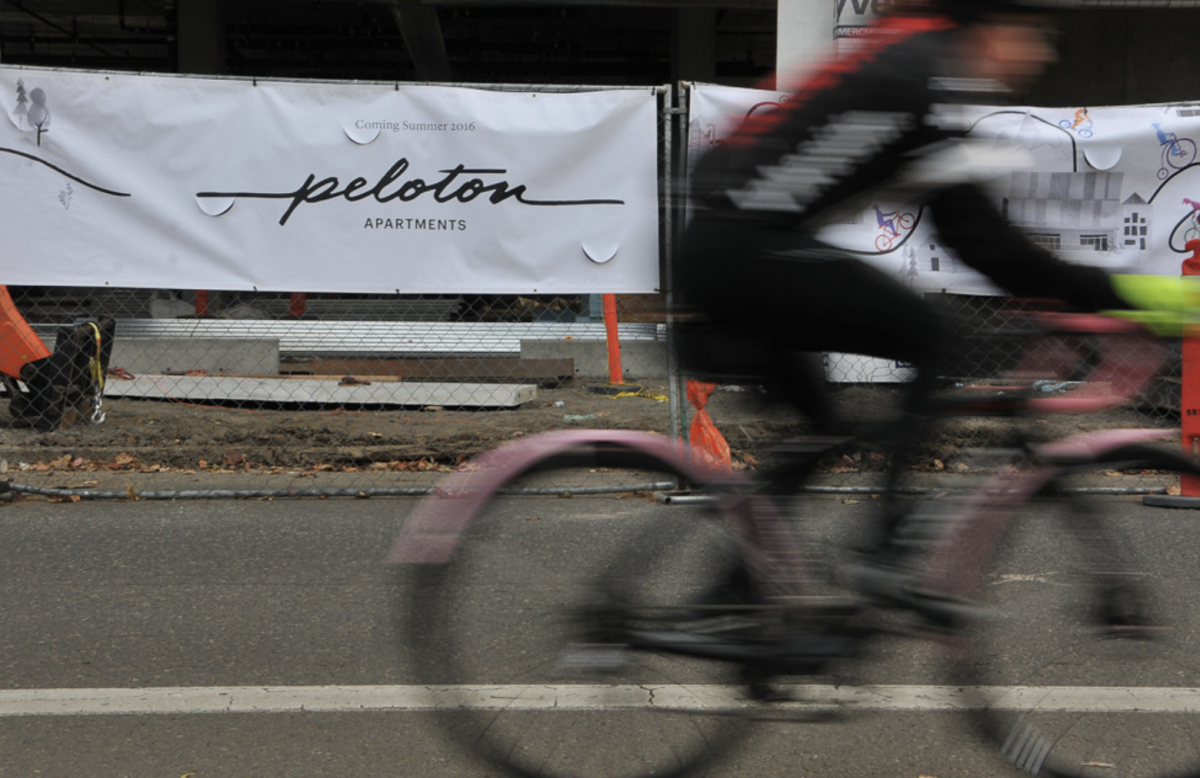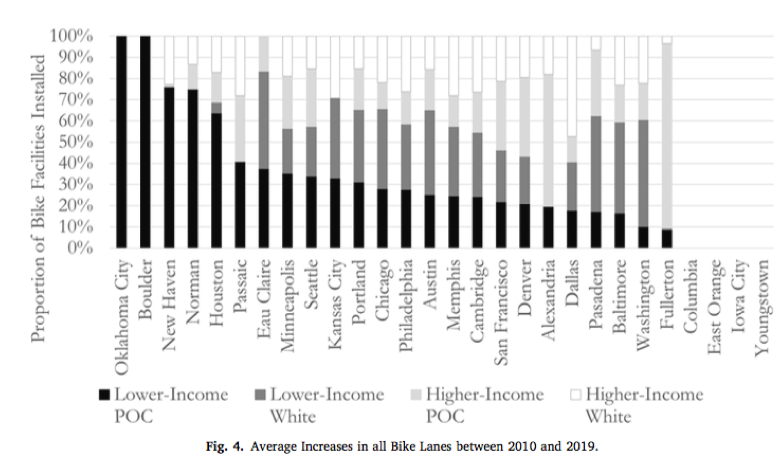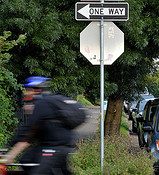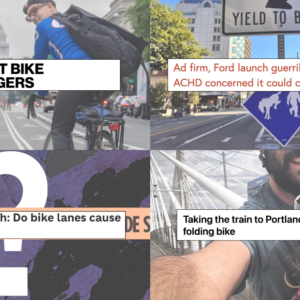
(Photo: Jonathan Maus/BikePortland)
The installation of new bike infrastructure in neighborhoods does not lead to displacement of people of color, and low-income areas received more “hard” facilities like buffered or protected bike lanes than high income areas, according to a new study published in July by Elsevier.
Researchers at the University of New Mexico and the University of Colorado looked at data from 29 U.S. cities over a period of ten years to come to a better understanding of the dynamic between socioeconomic and demographic characteristics and bike facilities. Looking at 11,010 miles of bicycling facilities in before and after bins of 2010->2014 and 2014->2019, they used sophisticated statistics to try to tease apart correlations and causality. Two questions they sought to answer were, “Does the installation of bicycling facilities lead to SED changes in a neighborhood or vice versa?” and “How well has the recent expansion of bicycling networks advanced transportation justice through appropriate distribution across the socioeconomic/demographic (SED) spectrum?“
Advertisement

Portland was one of the cities in their study group, and the authors gave PBOT and the GIS team a shout-out as the only city which included the year of facility installation as a data attribute. With the exception of Portland, “collecting facility data across time was a difficult and time-consuming manual process.”
This study was unique in that it distinguished between types of facilities, from sharrows to protected lanes. It found differences in who got what, with lower income areas more likely to receive protected bike lanes. By looking at the data longitudinally, they explored the “causality dilemma (i.e. chicken or egg) analysis.” Their interpretation of the results was that increases in the percentage of white people in a neighborhood preceeded an increase in bike facilities more so than the reverse, bike facilities preceeding a change in demographics. Put less formally, they could not find that adding bike facilities caused gentrification.
In 2011, a PBOT project to improve bike lanes on North Williams Avenue turned into a controversial debate as some neighborhood advocates saw the project as a harbinger of gentrification.
Like a lot of good research, their study leads to new questions. One area ripe for investigation is how well bike facility distribution meets demand:
the bicycling facility inequalities we found in the first part of this paper may be due to lack of community support in some neighborhoods. Trying to more evenly distribute such facilities by imposing them onto unwilling communities may be problematic. This point is why we use the term “inequality” throughout this paper as opposed to “inequity,” as it is still possible that the inequalities observed do indeed meet demand.
The paper is not available free, but libraries and schools might have subscriptions to Elsevier which allow you access. StreetsBlogUSA also has an article covering the research.
Nicholas N. Ferenchak, Wesley E. Marshall, “Bicycling facility inequalities and the causality dilemma with socioeconomic/sociodemographic change,” Transportation Research Part D, Elselvier, 2021.

— Lisa Caballero, lisacaballero853@gmail.com
— Get our headlines delivered to your inbox.
— Support this independent community media outlet with a one-time contribution or monthly subscription.








Thanks for reading.
BikePortland has served this community with independent community journalism since 2005. We rely on subscriptions from readers like you to survive. Your financial support is vital in keeping this valuable resource alive and well.
Please subscribe today to strengthen and expand our work.
I’m in the peculiar position of having the research paper in front of me, I’m guessing none of you do. You’re bringing up really good points, many of which are addressed in the excellent “Conclusions” section of the paper. I’ll pass on answers to a few of the questions.
One way that any study can go astray is in choosing the sample to study. These authors carefully selected their sample to represent a broad spectrum of cities which varied in SED characteristics, size, bike-friendliness and geography. The designations of POC and income were calculated for each individual city. In other words, high income in San Francisco is not that same as high income in Iowa City. Same for racial/ethnic categories, they are calculated based on that city’s average.
The authors state “Overall, there does not appear to be a strong causal relationship between bike facilities and SED variables, and there is an especially weak link in terms of bike facility installation leading to future SED changes.” That’s right, because they can’t even show correlation.
I’ll blow it if I try to explain what a p-value is, but the only characteristic that consistently reached statistical significance (p-value<0.05) was distance from the city center (which they control for when testing other attributes).
Anything involving SED got really insignificant p-values of 0.45, 0.6, 0.97, except that that an increase in income or percentage of whites was associated with installation of trails and sharrows. In aggregate, remember, across 29 cities.
In the Conclusions, the authors discuss the limitations of their study, including that they don't account for quality or bike network relevance of the facilities.
Causality is a complicated thing to study in social science, where researchers are limited to observational studies. Also, they don't have the money to do nuanced surveys of how people make their real estate decisions, the study requires a lot of statistical power (a lot of data points) to reach significance, so they are having to rely on large, publicly available data sets.
YIKES!! Bogged down in minutia. Why not build bike lanes simply because people want them, they make a more livable city, and they’re cheap?
a P value is basically just how likely it is that something occurs through random chance (and not specifically because of the things you’re testing or asking). Roughly a P value of less than 0.05, means there is a less than 5% chance that the difference is caused by random chance, thus it’s pretty likely there is a “significant” difference between the two things. you’re testing. The lower the p value the more “statistically significant” the relationship is, and less likely it is just “noise” or due to randomness or sampling error.
I’ve never formally studied statistics, but I think that definition of yours is the seat of the pants definition that drives statistics folks up the wall. P-value considers the “null hypothesis.” Not random chance, but the probability that the result you arrive at could have the same distribution as that resulting if your hypothesis were not true. There, you made me do it! I’ve probably also incorrectly tried to define p-value. Best just to stick to wikipedia:
It does bother statisticians, but it’s the most layman way to explain to someone who has absolutely no idea what you’re talking about.
The problem with your and wikipedia’s definitions are now you have to try to explain the “null hypothesis”. (on second that would actually be useful for most people to understand during these COVID times…..)
Well this will be an interesting discussion.
What if a given community simply believes otherwise?
Your truth is not *my* truth.
That’s true.
Consistent lols from middle of the road guy.
However, Portland cyclists are NOT the gentrifying problem. But they are an easy scapegoat. Gentrification is a huge problem, but bicyclists aren’t the contributing factor.
Protected bike lanes do not significantly cause gentrification. I would have caught this ten years ago when I started researching transport economics as an academic.
I don’t have the article in front of me. Nor do I care to dig. Bicycling does not cause gentrification. It was never a solid economic argument. Except for lazy journalist looking for bait click or ….special “equity facilitators” who.don’t.have.a.clue.
I very much appreciate that Lisa’s posts attempt to separate reality from inuendo and opinion through the use of high-quality facts and scientific research, thanks and please keep up the good work!
That lends credence to the complaint that white people get better bike infrastructure.
If the opposite had been true, it would have lent credence to the complaint that bike infrastructure leads to more white people (and if it’s the right kind of white people, gentrification).
Since complaints about bike lanes are all over the place, it is hardly surprising the data supports some subset of them.
That lends credence to the complaint that white people get better bike infrastructure.
While the study seems to suggest their conclusion, it doesn’t seem to take into account “low stress” bike facilities. East Portland in particular has more miles of bike lanes than any other section of the city. Most on high crash corridors and through most of the high crash intersections in the city. East Portland has been left behind when it comes to low stress biking facilities for the last 25 years, and the low stress biking facilities we do have have been secured by the homeless/houseless community.
You can bend the data as you wish.
East Portland has also been left behind on the sorts of small through streets on which “low stress” bikeways can be built, no doubt in anticipation that the area would not always be primarily white.
Consider the data bent.
I lived in Portland for 17 years and I sincerely bought the argument that improved bike infrastructure leads to gentrification and increased homelessness.
I now live in a low-status Deep South community that for decades has been deliberately trying to gentrify poorer (black) sections of town to no avail. They even have pushed buffered bike lanes, farmers markets, and more frequent bus service. The only parts of town successfully getting gentrified are middle-income white parts of town, in spite of a lack of sidewalks and good bike infrastructure.
When I visit Charlotte, Raleigh, or DC, I see lots of intensive construction of new apartments, fully protected bike facilities, sidewalks, green lanes, LRT/BRT, Whole Foods, etc. Lots of homelessness too. But I also note that the people moving in are well-educated, articulate, ride bikes, young urban professionals – in other words, the ambitious folks who got away from the community I live in, whereas those who remain in my community are the pleasantly mediocre, passive, religious, and addicted to driving.
Or as we like to say here, as mediocre as our community is and as inept as the public officials living and working here are, at least it ain’t some armpit city like Fayetteville.
To misquote the NRA, infrastructure improvements doesn’t cause gentrification, people cause gentrification.
It’s a rare graph (as shown above) that has Boulder CO as “low-income POC” (I can’t think of a higher income college town than Boulder) mixed with a tiny college community like Eau Claire and just a few bars lower is a city of 3 million (Chicago.)
Garbage in, garbage out.
The graph for Boulder confused me. I use the web site city-data.com as it will show racial mix for neighborhood blocks. The city itself is 79% white. I could not find any blocks that were 100% POC. I did find several that were a 100% white. The most diverse area is the University of Colorado campus.
You two are misinterpreting the y-axis. Boulder built 100% of its bike facilities in areas calculated to be where lower income POC live–the income and percentage of POC are calculated for that city.
Good article. Today I looked at the census data and was absolutely blown away by the level of displacement of Black people in the inner NE census tracks in Portland. Bike lanes don’t appear to be the issue, but we have massively failed as a city to combat rapid and massive displacement.
Shame on us.
Until government (take your pick, city, county, state, fed) works to eliminate barriers to education, housing, and employment we’ll always have people have to move from one area, because it becomes to expensive, to another cheaper area.
Portland welcomed all comers here with open arms, and where did they want to move to? Mostly areas where housing was cheaper.
Rent control might have helped to lessen that, but as we’ve seen in other cities, it’s very bad policy in the long term.
Being a popular city doesn’t bode well for the under-employed. I look at my own house and it’s value (according to Zillow) has doubled in the past 10 years. I can’t even begin to fathom trying to buy a house in current times with the crazy pricing.
When rent controls finally end, I bet there’s going to be a lot of movement by folks.
Interesting anecdote: a friend’s son is back in Portland this summer before heading off to his senior year at an east coast engineering school (he grew up here). Yesterday he got an excellent job offer, but told me “if I take it, I’d need to move back to Portland, and why would I want to do that?”
Good question. Why would someone just starting off come to Portland? I sure wouldn’t.
Then maybe Wheeler, Kafoury, and Schmidt have finally succeeded with their lack of doing anything for Portland’s citizens in getting people to look elsewhere to live.
You could ask the same of the whole country. Why would someone want to give tax money to support this government? It’s time young people start to brain-drain the US and take their talents somewhere that the government actually respects and supports them. Especially people of colour.
“Yesterday he got an excellent job offer, but told me “if I take it, I’d need to move back to Portland, and why would I want to do that?” ”
Because he’s been offered an excellent job?
Most college kids nationwide would say the same thing if you asked them if they wanted to move back home for a job right out of school. Why would they want to do that?
I think the main issue was he was shocked at how much Portland changed while he was gone, and living elsewhere has given him the perspective that other places just aren’t as jacked.
Between the smoke, heat, crime, homelessness, protests/street brawling, increasing cost of living, traffic mayhem, boarded up downtown, trash, and general sense of civic malaise/decay… well, a lot has changed in 3 years.
None of these undesirable qualities are unique to Portland and can be found in almost any city in the US at this point. The grass is always greener…
True, some of these elements can be found everywhere right now. But overall, Portland (along with other cities on the west coast) seems to be faring worse than most.
If all of the above were unique to Portland and a major issue for most buyers, we would see home prices falling in Portland, or at least lagging the averages nationwide increases.
The graph seems to suggest that 100% of the bike infrastructure in Boulder went to Lower Income POC neighborhoods. Having been to Boulder, it begs the question of what they consider “Lower Income” and “POC”.
Looking an N/NE Portland over the last few decades, I’d certainly agree that bike lanes didn’t create gentrification, because gentrification was well underway long before them.
The trickier question is how bike lanes impact gentrification that’s already started. I couldn’t tell if the study addressed that. At least in N/NE, lots of additional gentrification happened AFTER bike lanes went in. I think it’s certain that it would have happened without bike lanes, but it also seems plausible that bike lanes may have sped it up some. Bike lanes going in may give a “seal of approval” to real estate agents, developers, and potential new residents or businesses that an area has been noticed by the City, and the City is spending money on it.
When people talk about other people believing that “bike lanes cause gentrification” they’re usually talking about existing residents (those who may become displaced) thinking that. But I think it works the other way, too–people who are doing the gentrification also think that bike lanes cause (or at least contribute to) gentrification, and they view that as a positive, reassuring thing.
Does this happen in practice? Portland has gutter lanes all over the city. Most people don’t even notice them.
I could see it if Portland built platinum or even semi-acceptable bike and ped infrastructure, but some crappy paint on the ground doesn’t scream “up and coming” to me.
I think it does happen, and some of it happens before anything gets built, because people react to the announcement that bike lanes are coming. When people oppose proposed bike projects because they think it will lead to or increase gentrification, I don’t think most really care about the specifics of the project. And I think the same is true of people who I mentioned as seeing it as a positive, since most of them (like real estate agents or developers) don’t live in the area and may not bike. So I’m not sure the type of bike lane really matters. Certainly it doesn’t matter as much to those people as it does to people who actually will be biking there.
The whole issue is murky because bike lanes also often come with other things like sidewalk improvements, Urban Renewal Area designations, etc. So it seems almost impossible to isolate the impact of the bike lanes on gentrification/development/investment.
The city is building bike lanes on Powell, east of 205. I immediately thought it would be a good time to buy a building and sit on it for investment purposes. I didn’t think that until I observed bike lanes.
It’s actually ODOT that is building the lanes, not PBOT. ODOT is upgrading the painted lanes they’ve had for decades to cycletrack-type protected bike lanes and adding sidewalks plus a center turn lane and numerous pedestrian islands. $130 million altogether, from 99th to 174th.
East Portland has had bike lanes for two decades now and is only in the last couple of years really gentrifying.
Gentrification is the end result of the actions of thousands of individuals. I just don’t think there is any evidence that folks hold bike lanes in such regard that they make decisions about where to live based on where bike lanes will be in the future.
I could see those signals being sent by real investments such as a new highway or light rail line though.
Right, because the opposition to the bike lanes doesn’t really have anything to do with the bike lanes. It’s opposition to the inevitable gentrification of an area.
I don’t really see what your theory is here. Your idea is that no one actually cares about the bike lanes because no one bikes, but apparently unprotected gutter lanes are a harbinger of investment by the city, even though you can look all over Portland and see that it’s not true and that somehow drives gentrification.
There just isn’t any real evidence of that. This study refutes that notion and we kind of how have an example with N Mississippi and N Williams, one with bike lanes and a ‘greenway’ near it and one with no bike lanes close and only a ‘greenway’ near it, but both streets gentrified all the same.
I had a hand in “gentrifying” three neighborhoods. The first was Potrero Hill in SF when I moved there in 1970, desperate to escape the Mid-Peninsula upper middle class ghetto. North Beach was my dream, but that was long beyond reach, no longer the artist haunt of the Beat days. Helped start a neighborhood newspaper, The Potrero View, and otherwise contributed to making it a better served part of San Francisco, famous for underserving those “South of the Slot.” Failed to buy a two bedroom Victorian for $20K and later passed on a two flat unit for $60K. Got mugged twice, but rents were cheap and the views super.
Next a return to Portland in 1986, married and looking for a quarter with some character and street life that hinted of SF. So it was NW, where an apartment was for rent every block, and several were ready to have us…me a jobless musician with Cal unemployment $.
Again it was very affordable…$300/mo for a one bedroom! Got swept up in the Good Old Houses campaign, did 6 hours hard time in the Justice Center, and made a speech suggesting that only “more crime and graffiti could save NW from “progress” and the “G” word.
Last, it came time to buy a house, and of course NW was off the charts…$150K for a little dump! So we cast our eye to SE and finally found something we liked and could afford “Beyond the Pale” on the far side of then SE 39th. Some cultural wars ensued…drug dealer neighbors, dogs that barked all night, trash all over the yard; the usual stuff.
But outer Inner SE got hot, especially between Belmont and Hawthorne, and we made out like bandits and put all that dough into a really nice Bungalow in “Almost Irvington.”
What’s the story here? People starting out with some, but not a lot a resources, look to settle in parts of a place that are affordable, affordable, affordable, and interesting, lively, diverse if you can manage it. And they get involved in getting better transit service and schools, and even bike lanes. More retail opens up, and all together is makes a place more attractive! Watch out…attractive and affordable is a deadly mix!
What happened in N/Inner NE was simple and had as little to do with who the existing residents were as elsewhere…it was the last affordable close in neighborhood; everything else was taken. Add a new MAX line up Interstate and the big new adidas HQ with tons of young well paid employees, and that’s all she wrote. Some long time residents did well…an TriMet Op I knew couldn’t believe that the Alberta house he paid $17K for was worth 10 times that! But renters…whether residents or businesses take it one the chin and must pull up stakes and move to cheaper pastures…if there are any. Capitalism sucks!
I live on 80th and Taggart near Division street. The city is making 80th to 174th safer: bike lanes, better bus stops, cross walks, etc.. I count several buildings just east of 82nd on Division at risk of being developed. Although, I can’t refrain from saying sooner than later. Right now it’s boarded up buildings, broken down cars, car lots, and strip clubs. Bring on the five story buildings, the professionals and ebikes.
I have issues with the study based on demographic change seen over greater than 20 years in our city.
Pdx is very white (71%) [white, non latino] vs the nation as a whole (60.1%) [white, non latino].
Now lets throw in the trends sourced from the city itself:
1970 black population of Portland:
https://www.portlandoregon.gov/phb/article/652915
Portland African American: 6%
North/Northeast: 22%
1980: https://www.portlandoregon.gov/phb/article/652916
Portland African American: 8%
North/Northeast: 28%
1990: https://www.portlandoregon.gov/phb/article/652917
Portland African American: 8%
North/Northeast: 31%
2000: https://www.portlandoregon.gov/phb/article/652919
Portland African American: 7%
North/Northeast: 25%
2010: https://www.portlandoregon.gov/phb/article/652920
Portland African American: 6%
North/Northeast: 15%
Something has happened in N/NE Portland to the black community, and as a proportion of Portland as a whole (hint: decline).
The N/NE Portland Black community has declined by 16% since 1990. Meanwhile, the black community of Portland has declined by 2% since 1990.
We are going to see a ton of new data from the 2020 census and it is accurate enough, however our issue is the questions being proposed. Over 20 years the changes are more dramatic vs 10 years. Studies always are good at answering specific questions. In the case of N/NE Portland demographic change had its biggest impact starting from 1990.
Anyways, that’s the demographic part (as far as I know).
And as for the crux of the study: bike lanes can be a byproduct of gentrification, not necessarily a precursor. But lets be real, infrastructure investments tend to improve property values. But a bike lane’s multiplier on property values is not as large as say a fixed rail line.
There needs to be larger investments than bike lanes to gentrify. This is to say: a bike lane won’t displace people – but boosters combined with major infrastructure investments likely will, and eventually they might build some bike lanes.
Anyways, living next to a bike blvd or green street is amazing. I wish I still could, but alas the real estate market in Portland is too hot and I had to move. I would love to hear from some homeowners if they experienced an uptick in property value. (there has to be some data that approximates the value of living on a bike blvd vs not, or before construction value and after)
Just a heads up: Elsevier is just the publisher (and they have many journals under their umbrella). The journal the article was published in is: Transportation Research Part D: Transport and Environment